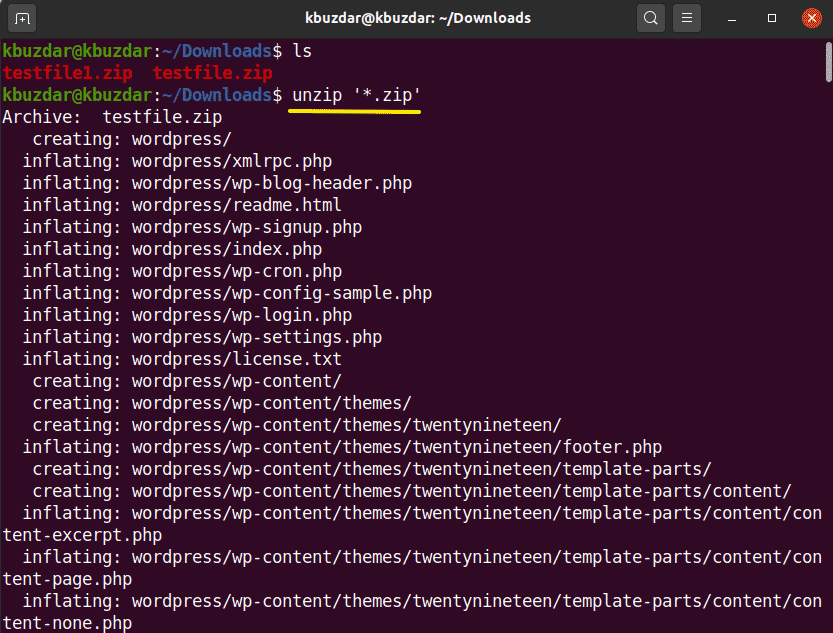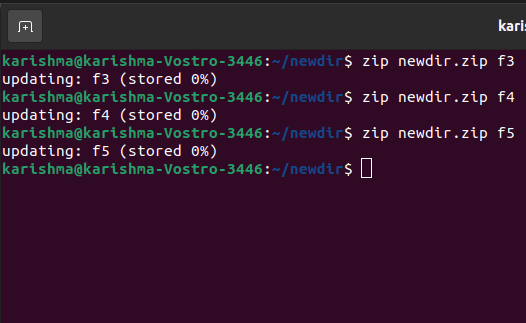

- #Zip folder linux command line how to
- #Zip folder linux command line install
- #Zip folder linux command line zip file
- #Zip folder linux command line archive
You can freely download 7-zip.exe file from Click here to download 7-Zip.exeĪfter download 7-zip.exe you have to double click the file and install it. Moreover 7zip is distributed under LGPL license as a free software to use. The main features of 7z format are it has high compression ratio and it supporting files with sizes up to 16000000000 GB.
#Zip folder linux command line archive
Besides operating on the 7z format, it supports many other popular archive formats and can seamlessly work on them. By default, 7-Zip creates 7z format archives with a. The 7-Zip utility can be used from a command line interface, graphical user interface, or with a window-based shell integration. It is a file archive compression utility that can be used on any computer. zip -s 0 split.zip -out unsplit.zip unzip unsplit.zip.7-Zip is an open source software. If you want to test the result, unzipping split archives, takes a little more effort, as 2 commands are needed one to unsplit and one to unzip:Į.g.


zip -r -s 2g readyToUpload.zip “My Files for Copyright Registration” The ‘-s 2g’ option tells zip to split the archive into chunks of 2GiB size Į.g. If you are comfortable using the Linux or Mac command line, the zip program just requires one small change to the command above:
#Zip folder linux command line how to
You will need to read the documentation for the specific program for instructions on how to split archives. There are software programs such as WinZip (for windows), 7zip (for Windows), p7zip (for Linux) or StuffIt Expander (for Mac, iOS & Windows), that provide more advanced features. The simplest option here is to share the files across 2 (or more) directories and create Zip files for each directory. There are a few options, depending on how technically minded you are: zip archive is larger than the per file upload limit (currently 2GiB), you should split the work up into 2 or more zip files. The same commands should work on a Mac as well. unzip myFiles.zip.Īs Linux and Mac operating systems are both Unix based they operate very similarly. If you want to test that everything is as expected, you can extract the contents with the command unzip, e.g.
#Zip folder linux command line zip file
Use quotes around the zip file or folder name if the name contains any spaces. The '-r' option tells zip to include files/folders in sub-directories.įor example: zip -r readyToUpload.zip "My Files for Copyright Registration"

If you open a terminal console in the parent directory, or used the cd command to navigate there from the command line, you should then be able to run the command on the folder. Linux (and Mac terminal) command lineĭepending on the Linux distribution you may have different GUI options (or none), but you will almost certainly have zip installed as a command line program. If you want to test that everything is as expected, you can unzip a ZIP file, by right clicking on the file and selecting 'Extract All' from the context menu. If you are on a Windows desktop, right click on the folder, hover over/select 'Send to' on the context menu and then select 'Compressed (zipped) folder'. If you want to test that everything is as expected, you can unzip a zip file again, either by double clicking the file or bringing up the context menu and selecting 'Open with' and choosing the unzipping program (probably called "Archive Utility"). To compress the folder on an Apple Mac, select the the folder and bring up the context menu by either:Ĭhoose “Compress” from the shortcut menu. First get all the files that you need to submit together in a folder on your computer.įor most operating systems, the ability to create zip files should be already available to you without installing any extra software.


 0 kommentar(er)
0 kommentar(er)
